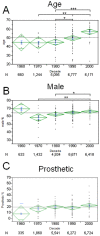Infective endocarditis epidemiology over five decades: a systematic review
- PMID: 24349331
- PMCID: PMC3857279
- DOI: 10.1371/journal.pone.0082665
Infective endocarditis epidemiology over five decades: a systematic review
Erratum in
- PLoS One. 2014;9(10):e111564
Abstract
Aims: To Assess changes in infective endocarditis (IE) epidemiology over the last 5 decades.
Methods and results: We searched the published literature using PubMed, MEDLINE, and EMBASE from inception until December 2011.
Data from: Einstein Medical Center, Philadelphia, PA were also included. Criteria for inclusion in this systematic review included studies with reported IE microbiology, IE definition, description of population studied, and time frame. Two authors independently extracted data and assessed manuscript quality. One hundred sixty studies (27,083 patients) met inclusion criteria. Among hospital-based studies (n=142; 23,606 patients) staphylococcal IE percentage increased over time, with coagulase-negative staphylococcus (CNS) increasing over each of the last 5 decades (p<0.001) and Staphylococcus aureus (SA) in the last decade (21% to 30%; p<0.05). Streptococcus viridans (SV) and culture negative (CN) IE frequency decreased over time (p<0.001), while enterococcal IE increased in the last decade (p<0.01). Patient age and male predominance increased over time as well. In subgroup analysis, SA frequency increased in North America, but not the rest of the world. This was due, in part, to an increase in intravenous drug abuse IE in North America (p<0.001). Among population-based studies (n=18; 3,477 patients) no significant changes were found.
Conclusion: Important changes occurred in IE epidemiology over the last half-century, especially in the last decade. Staphylococcal and enterococcal IE percentage increased while SV and CN IE decreased. Moreover, mean age at diagnosis increased together with male:female ratio. These changes should be considered at the time of decision-making in treatment of and prophylaxis for IE.
Conflict of interest statement
Figures






References
-
- Bayer AS (1993) Infective endocarditis. Clin Infect Dis 17: 312-321; quiz: - PubMed
-
- Duval X, Delahaye F, Alla F, Tattevin P, Obadia JF et al. (2012) Temporal trends in infective endocarditis in the context of prophylaxis guideline modifications: three successive population-based surveys. J Am Coll Cardiol 59: 1968-1976. doi: 10.1016/j.jacc.2012.02.029. PubMed: 22624837. - DOI - PubMed
Publication types
MeSH terms
LinkOut - more resources
Full Text Sources
Other Literature Sources
Medical
Miscellaneous

